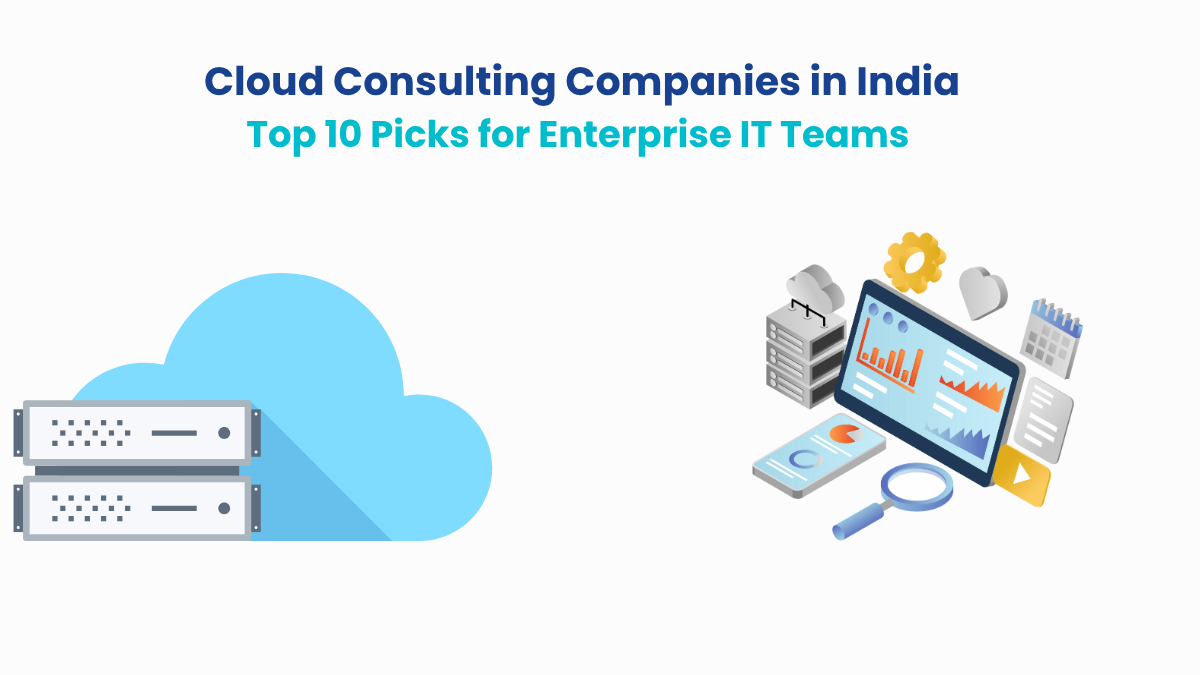Your team is exhausted. The alerts don’t stop. And no matter how many dashboards you wire up, the real risk never feels under control. You might have lost two Tier-1 analysts this quarter. Or Maybe your detection SLAs are slipping. Maybe you’re still trying to stitch together visibility across AWS, Azure, and whatever shadow IT popped up last month.
If you’re a CISO, head of security operations, or responsible for managing your enterprise’s security posture, you know this pressure. And you’re not alone.
In 2024, the Asia-Pacific region accounted for 34% of global cyber incidents, the highest share in the world. And attackers aren’t brute forcing anymore either. They’re logging in with valid credentials. Nearly 30% of breaches now involve identity-based attacks.
It’s only going to get louder. More phishing, infostealers, and AI-fueled intrusions. You cannot afford indecision.
You have to make the call: double down on internal security or find the right partner to scale your defenses.
This article breaks down the realistic scenarios where outsourcing managed security services makes strategic sense. It also shows you when keeping it in-house is the smarter move.
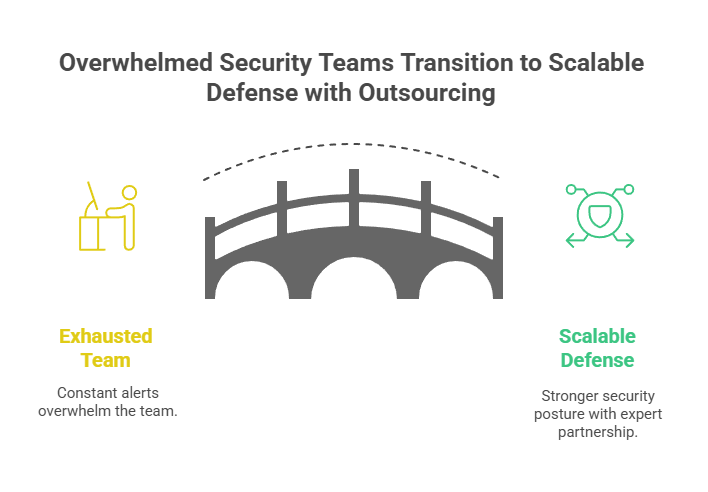
Scenario 1: When Burnout Becomes a Breach Risk
Inside most enterprises, burnout doesn’t start with fatigue. It starts with fragmentation. Too many tools and disconnected alerts. Too many “temporary” workarounds that quietly become permanent. Analysts end up triaging noise instead of threats, babysitting dashboards instead of responding to real incidents.
That’s how mistakes creep in and SLAs get missed.
According to ISACA’s 2024 State of Cybersecurity report, 66% of cybersecurity professionals say their roles are more stressful now than they were five years ago.
At that stress level, risk isn’t just theoretical; it’s operational. Tuning gets delayed. Playbooks stay outdated. Response times stretch. And then something slips through.
This is where outsourcing managed security services makes strategic sense. Not as a replacement, but as a relief valve. A mature MSSP brings 24×7 coverage, tuned detection logic, and operational breathing room. It helps your best people stay sharp where it matters most.
If you’re considering automation to reduce burnout and streamline repetitive triage tasks, the Practical Guide to Deploying SecOps Automation walks you through proven playbooks and real-world use cases for making your SOC more efficient, without overloading your team.

Scenario 2: When Multicloud Expansion Breaks Your Visibility
Managing security across multiple cloud platforms— like AWS, Azure, GCP—introduces complexity that can obscure visibility and increase risk. Each platform has its own tools, configurations, and security protocols. This makes unified monitoring a significant challenge.
According to Microsoft’s 2024 State of Multicloud Security Risk Report, more than 50% of cloud identities had access to all permissions and resources. This over-permissioning, often a result of misconfigurations, creates potential attack vectors.
Additionally, 74% of organizations experienced at least one data security incident involving business data exposure. The lack of centralized visibility and control across cloud environments contributes to these incidents.
Outsourcing to a Managed Security Service Provider can address these challenges.
However, it should be noted that not all MSSPs are built for multicloud complexity. Those with deep multicloud expertise offer centralized monitoring, standardized security policies, and the ability to handle cloud-native risks at scale. If you want to know how to choose a multicloud-ready MSSP, this quick guide will come in handy.
Scenario 3: When You’re Missing SLA Targets for Detection and Response
Speed is everything in security. But when your internal team is buried under alert fatigue, tool sprawl, and manual triage, meeting critical SLAs becomes a losing game.
The 2024 IBM Cost of a Data Breach Report found that organizations with faster threat containment times—under 200 days—saved an average of $1.39 million compared to those with longer dwell times. But that speed rarely comes from overworked internal teams. As those teams juggle too many tools without automation or escalation support, the gap in response speed becomes a direct driver of cost and exposure.
Metrics like missed MTTD (mean time to detect) and MTTR (mean time to respond) don’t just hurt KPIs. They translate directly to higher breach costs, compliance risk, and reputational damage.
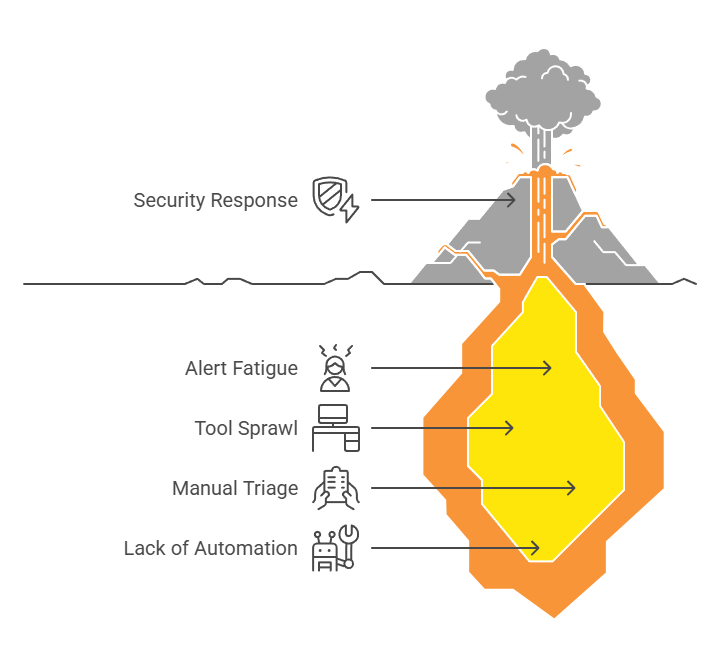
Recommended Read: 15 SOC Metrics Every CISO Must Track to Prove and Improve Security Performance.
An MSSP can close this gap. With mature runbooks, Tier-1 triage automation, and 24/7 coverage, they can help you hit detection and response targets consistently.
Scenario 4: When You Need Skills You Can’t Hire For
The cybersecurity talent shortage is not just a hiring challenge; it’s a strategic risk. In 2024, the global cybersecurity workforce gap reached nearly 4 million professionals. This deficit is most visible in roles tied to AI, cloud infrastructure, and incident response.
According to the Fortinet Report, the most difficult roles to fill are security operations and cloud security. Additionally, 62% of security leaders say it’s difficult to find candidates with network engineering and security experience. This scarcity hampers the ability to protect against sophisticated threats and implement advanced security measures.
Outsourcing to a capable managed security service provider can bridge this gap. MSSPs maintain teams of experts with specialized skills, offering access to advanced threat detection, incident response, and compliance management capabilities that are often out of reach internally.
By outsourcing managed security services, organizations can enhance their security posture without the prolonged timelines and costs associated with building these capabilities in-house.

Scenario 5: When Compliance Becomes a Moving Target
In the current regulatory environment, maintaining compliance is an ongoing challenge. Frameworks like India’s Digital Personal Data Protection Act (DPDPA), the European Union’s GDPR, and the U.S. HIPAA impose stringent requirements and substantial penalties for non-compliance.
For instance, under the DPDPA, organizations can face fines of up to ₹250 crore (approximately $30 million) for significant violations, such as failing to implement adequate security safeguards. The GDPR allows for penalties up to €20 million or 4% of a company’s global annual turnover, whichever is higher. HIPAA violations can result in fines ranging from $100 to $50,000 per violation, with an annual maximum of $1.5 million, depending on the level of negligence.
Navigating these complex and evolving regulations requires specialized expertise and continuous monitoring.
Most Managed Security Service providers offer compliance-focused services, including risk assessments, policy development, continuous monitoring, and audit support. By partnering with an MSSP, organizations can proactively manage compliance obligations, reduce the risk of costly penalties, and focus on their core business operations.
Recommended Read: 9 Reasons businesses fail compliance certification and how compliance consulting can prevent it?
Scenario 6: When Your Cyber Budget Needs Predictability
Cybersecurity is no longer a back-office expense. It’s a board-level line item. But as security teams scale across cloud, hybrid work, and evolving threat surfaces, the costs get harder to predict. Hiring senior analysts, maintaining multiple tools, and paying for yet another point solution adds up. Worse, it adds up unevenly.
This is where outsourcing managed security services makes financial sense. Instead of variable costs tied to people, platforms, and alerts, MSSPs offer outcome-based pricing. You pay for coverage and capability. Not headcount or fire drills.
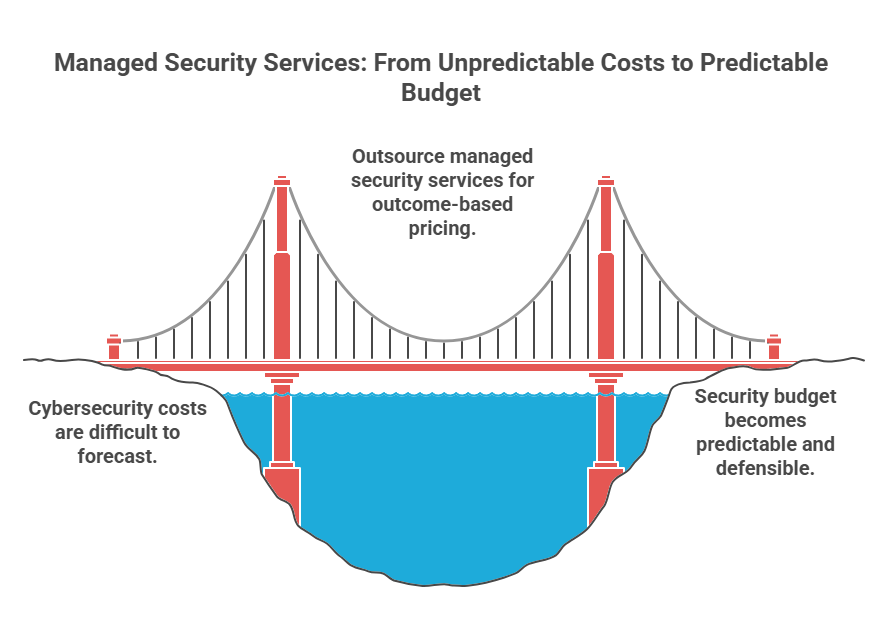
It also reduces waste. You don’t need to overprovision tools “just in case” or scramble to hire expertise every time a new framework or threat comes up. With the right partner, your security budget becomes something you can forecast. And defend at the boardroom table.
Scenario 7: When You’re Preparing for an Audit, M&A, or Cyber Insurance Review
There are moments when your security posture isn’t just an internal concern. It becomes a headline in your investor deck, a due diligence checklist, or a deal-breaker in M&A.
Whether you’re facing a government audit, ISO 27001 review, or applying for cyber insurance, these checkpoints demand more than good intentions. You need airtight documentation, real-time visibility, and evidence of continuous control monitoring. That’s where many internal teams stumble. Not for lack of effort, but for lack of bandwidth.
Outsourcing managed security services can accelerate this maturity. A good MSSP will already have audit-ready logging, policy documentation, incident tracking, and control validation built into their delivery model. Instead of scrambling to assemble a narrative, you walk in with reports and confidence.
Outsourcing isn’t about giving up control. It’s about buying time, scale, and coverage that your internal team can’t sustainably deliver. It is especially critical in multicloud environments, high-stakes audits, or when 24/7 coverage becomes non-negotiable.
But not every organization is in that place. In fact, there are situations where outsourcing can slow you down, dilute ownership, or even create more complexity.
Let’s look at three scenarios where keeping security in-house is still the smarter move.
Scenario A: When You Already Have a High-Performing Internal SOC
If you’ve invested years into building a mature internal SOC, complete with tight processes and real-time detection pipelines, outsourcing could actually set you back. Teams like this carry deep institutional knowledge that can’t be easily replaced or replicated.
No MSSP, no matter how skilled, can match the internal context your team has about your infrastructure, applications, or risk appetite. Forcing a handoff to an external partner can introduce friction. Response times may stretch. Context gets lost. Custom workflows—built around your team’s strengths—can start to break down.
This doesn’t mean MSSPs aren’t valuable. In setups like yours, they may be more effective in a hybrid model. Think threat hunting, forensic investigations, or surge support during red-team assessments.
If your internal SOC is delivering, nimble, and well-integrated with your business? You’re not just secure. You’re ahead of the curve. Hold that line.
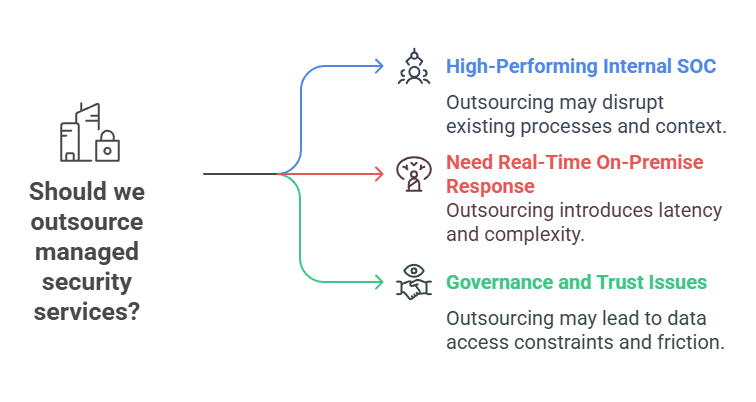
Scenario B: When You Need Real-Time, On-Premise Response Control
There are environments where milliseconds matter. Think critical infrastructure, defense, high-frequency trading, or regulated industries with strict on-premise data residency rules. In these cases, you don’t need just alerts. You need instant action from people who are physically close to the systems.
Most MSSPs, even the best ones, are optimized for remote response. That works for many use cases. But if your IR process depends on someone walking into a data center, isolating a machine, or interfacing with physical hardware, outsourcing introduces latency you can’t afford.
You may also be running tightly integrated controls across IT and OT systems. Outsourcing that level of granularity can create unnecessary complexity and new risks.
If physical proximity, ultra-low-latency, or strict sovereignty requirements define your operating model, you’re better off building in-house capabilities.
Scenario C: When Governance and Trust Issues block External Visibility
In some organizations, the biggest blocker to outsourcing isn’t capability. It’s culture. Leadership may be wary of giving external vendors access to sensitive logs, employee data, or executive communication patterns. Legal or regulatory teams might be concerned about data residency or breach liability. You might also be operating in a sector where customer contracts prohibit sharing certain telemetry with third parties.
Whatever the reason, when trust is limited, the MSSP relationship becomes constrained. You’re constantly negotiating access. You end up withholding key data or building side processes to mask sensitive activity. That erodes the value of the partnership.
In such environments, outsourcing managed security services may not just be ineffective. It may create more friction than it solves.
Until the governance posture evolves, it’s better to keep security in-house. Full visibility. Full control.
You’ve seen the scenarios. Some call for internal control. Others demand outside scale. But if you’re still on the fence, it’s time to step back and ask yourself the hard questions. To help you, we have added a quick decision-grade checklist below. It can help you figure out whether or not outsourcing managed security services is the right move for your organization.
A Final Checklist for Decision-Makers
If you’re still weighing the pros and cons, here’s a quick gut-check. The more of these you answer “yes” to, the more urgent your case for outsourcing becomes:
- Are your detection and response SLAs slipping or barely being met?
- Does your team struggle to manage visibility across multicloud workloads?
- Have you lost senior analysts in the past 6 to 12 months with no strong pipeline to replace them?
- Are compliance requirements (like DPDPA, GDPR, or ISO 27001) growing faster than your internal capabilities?
- Are you paying for security tools that are underutilized or misconfigured?
- Do board or executive stakeholders keep asking for reports that your team struggles to generate?
- Are you preparing for a major audit, M&A, or insurance assessment in the next year?
- Is 24/7 monitoring essential but unrealistic with your current staffing?
If you answered yes to more than three of the above, it may be time to stop patching gaps and start scaling security. And that’s where the right MSSP can make all the difference.
What Outsourcing Managed Security Services Looks Like When It’s Done Right?
When the time comes to scale your security operations, whether fully or selectively, you need a partner who can step in without disruption. You also need clarity from day one. That’s exactly where Datacipher comes in.
We are not just another MSSP. We work with some of India’s most ambitious enterprises to co-manage modern, multicloud security environments with real-world complexity. Whether you are operating across AWS, Azure, and on-prem workloads or preparing for compliance audits under DPDPA and ISO 27001, we have done it. We know what is at stake.
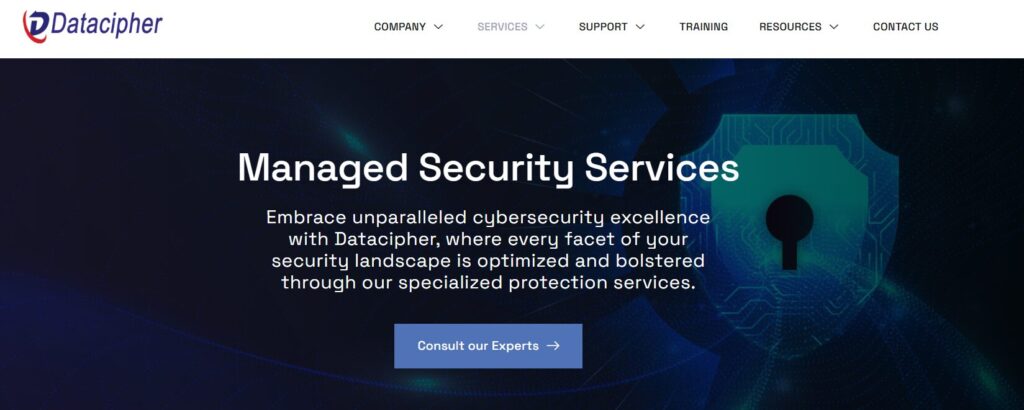
Our MSSP capabilities include, but are not limited to:
24×7 monitoring and alert triage: We offer always-on monitoring and frontline triage that filters noise from real threats. Your team gets signals, not overwhelm, and risks are escalated with context.
Managed Detection and Response: Our MDR services combine threat intelligence, automated workflows, and expert analysis. This gives you rapid detection and effective containment before incidents spiral.
Security posture management across multicloud: We help unify your security posture across AWS, Azure, GCP, and hybrid environments. That includes consistent policies, visibility, and threat coverage.
Log correlation and threat intel integration: Our analysts use correlated log data enriched with global threat intelligence. That means faster root-cause analysis and smarter decision-making.
Compliance mapping and audit support: We align your controls with standards like DPDPA, ISO 27001, GDPR and more. Our audit support packages include policy review, gap assessment, and evidence collection.
Co-managed models that preserve internal control while expanding coverage: You do not have to give up ownership. Our co-managed approach lets your team retain control while we provide the scale and speed to cover blind spots.
Last year, a manufacturing enterprise came to us after struggling with cloud visibility and failing internal SLAs. Their team was solid, but stretched. We did not replace them. We embedded alongside them. Within 60 days, they had consolidated their alerting pipeline, reduced false positives by 47 percent, and passed their ISO audit with zero remediation items. That is what a true MSSP partnership looks like.
Whether you need full-spectrum security operations or targeted coverage, Datacipher brings both. We offer the depth, flexibility, and regional expertise to make it work.
Ready to explore how we can support your security strategy? Schedule a consultation with our experts today.
Frequently Asked Questions
1. What is typically included in a managed security services contract?
An MSSP contract usually includes 24/7 monitoring, incident detection and response, log management, threat intelligence integration, and regular reporting. Some providers also offer compliance support, vulnerability assessments, and co-managed SOC options. The scope depends on your needs; modular contracts allow you to outsource select functions while retaining control over others.
2. Can I outsource only part of my security operations?
Yes. Many enterprises take a hybrid approach—outsourcing Tier-1 alert triage, threat hunting, or compliance tasks while keeping core detection or response in-house. This model works well when you have a strong internal team but need scale or expertise in specific areas. A good MSSP will tailor services to fit your operating model, not replace it wholesale.
3. How long does it take to fully onboard with an MSSP?
Full onboarding can take anywhere from 4 to 12 weeks, depending on complexity. The timeline includes integrations with your existing tools, defining escalation paths, aligning SLAs, and tuning detection rules. A seasoned MSSP will offer a structured onboarding plan with clear milestones, ensuring operational readiness without disrupting existing workflows.
4. What risks should I consider when outsourcing security?
Key risks include loss of context, vendor lock-in, limited visibility into incident workflows, and data handling concerns. To mitigate this, ensure your MSSP offers transparency, customizable reporting, and clear SLAs. Ask how they handle data sovereignty, chain of custody in incidents, and escalation protocols. The right partner should reduce risk, not introduce new blind spots.
5. Will outsourcing affect my SOC team’s roles and responsibilities?
Outsourcing doesn’t eliminate your SOC; it redefines it. Your internal team can shift from alert fatigue to strategic focus: threat modeling, tuning detection rules, and leading incident response. MSSPs can handle noise, baseline monitoring, or after-hours coverage. The key is defining boundaries clearly so your team retains control where it matters.
6. What’s the difference between MDR, MSSP, and XDR providers?
MSSPs focus on broad security operations like log monitoring, policy enforcement, and escalation. MDR providers specialize in active threat detection and response using curated tools. XDR is a product-driven approach that correlates data across endpoints, networks, and cloud services. Some MSSPs bundle MDR and XDR capabilities. The key is choosing based on operational need, not labels.


